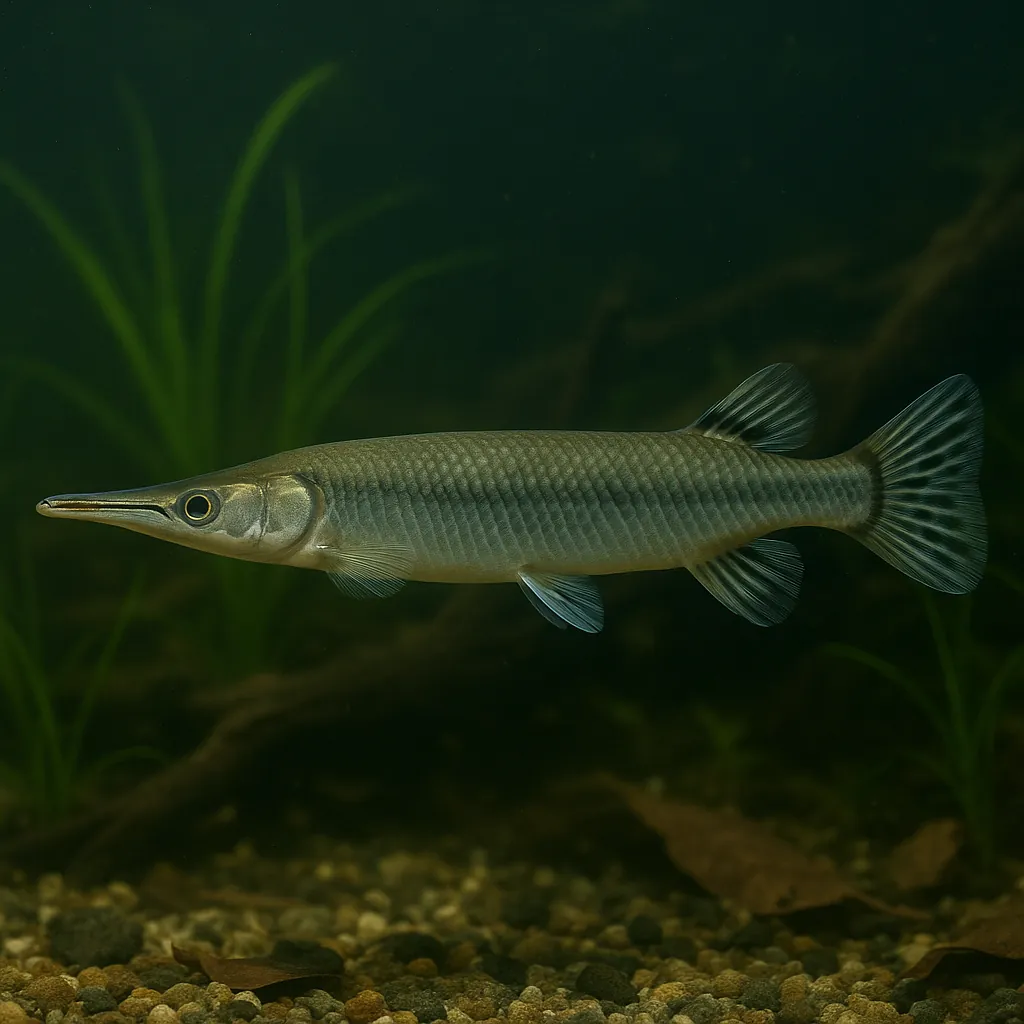
Freshwater garfish
Introduction
The Freshwater Garfish, scientifically known as Xenentodon cancila, is a captivating species that appeals to aquarists due to its slender, elongated body and distinctive beak-like snout. Resembling a miniature gar, this fish adds a unique aesthetic to home aquariums. While its appearance is intriguing, the Freshwater Garfish requires specific care and attention, making it more suitable for aquarists with some experience.
What makes the Freshwater Garfish stand out in an aquarium?
Its sleek, needle-like body and predatory nature provide a dynamic visual, especially when it actively hunts live prey near the water's surface.
Is the Freshwater Garfish suitable for beginners?
Due to its specific dietary needs and tank requirements, it's better suited for aquarists with intermediate experience.
Care and Environment
Proper care for the Freshwater Garfish involves attention to tank size, water parameters, and diet. Given its potential length of up to 40 cm, a spacious tank is essential. A minimum tank size of 280 liters is recommended for a single fish, with larger volumes preferred for groups.
What are the ideal water conditions for the Freshwater Garfish?
Maintain a temperature between 22–27°C, pH levels of 6.9–7.6, and water hardness ranging from 10–24°dGH. Consistent water quality is crucial for their health.
Filtration should be efficient to handle the bioload, but avoid creating strong currents, as these fish prefer calm waters. Lighting can be moderate, with floating plants providing shaded areas and mimicking their natural habitat.
What should I feed my Freshwater Garfish?
They are strict carnivores, primarily feeding on live foods such as small feeder fish, ghost shrimp, and crickets. Some individuals may adapt to frozen foods over time, but live prey is generally preferred.
Tank decor should include fine gravel or sand substrates, along with rocks and ample floating plants to offer hiding spots and reduce stress. Ensure the tank has a tight-fitting lid, as Freshwater Garfish are known jumpers.
Are there any specific challenges in keeping Freshwater Garfish?
They can be sensitive to sudden changes in water parameters and may exhibit aggression towards smaller tank mates. Regular monitoring and maintenance are essential to prevent health issues.
Origin and Habitat
Native to South and Southeast Asia, the Freshwater Garfish inhabits freshwater and slightly brackish rivers, streams, and estuaries in countries like India, Sri Lanka, Bangladesh, Myanmar, Thailand, and Malaysia. They favor slow-moving waters rich in vegetation and often stay near the surface.
What type of environments do Freshwater Garfish prefer?
They thrive in calm, slow-flowing waters with abundant plant life, providing both cover and hunting grounds.
Do they inhabit brackish waters?
Yes, they can be found in both freshwater and slightly brackish environments, showcasing their adaptability.
Temperament and Compatibility
Freshwater Garfish are generally peaceful towards their own species and can be kept in groups of three or more to reduce stress. However, they are predatory and may view smaller fish as prey.
What tank mates are suitable for Freshwater Garfish?
Ideal companions include similarly sized, non-aggressive species that occupy different tank levels, such as larger tetras or peaceful cichlids.
Can Freshwater Garfish be kept with smaller fish?
It's not advisable, as they may prey on smaller tank mates. Choosing fish of similar size helps prevent predation.
To create a harmonious tank community, avoid housing them with fin-nipping or aggressive species, as their slender form and delicate fins make them susceptible to injury.
Interesting Facts
The Freshwater Garfish exhibits several fascinating traits that intrigue aquarists. For instance, they are known to spawn in home aquariums, with eggs laid among floating plants and hatching after about ten days. However, raising the fry can be challenging due to their cannibalistic tendencies.
How do Freshwater Garfish hunt in the wild?
They are ambush predators, often floating near the water's surface and striking swiftly at unsuspecting prey with their sharp teeth.
Are they related to the North American gar species?
Despite the similar name and appearance, they are only distantly related to North American gars, belonging to different families.
Another intriguing aspect is their ability to adapt to slightly brackish waters, showcasing their resilience and versatility in various aquatic environments.
Sources
All information in this article has been gathered from the following reputable sources:
Overview
Recommended Tank Size 105.7 Gallons (for groups of 3 or more) |
Minimum Group Size 3 |
Minimum Tank Volume 74 Gallons |
Maximum Adult Length 15.7 inches |
Average Adult Length 14.2 inches |
Shoaling (6+ required) Yes |
Preferred Water Type Freshwater, slightly brackish |
Temperature Range (°C) 22–27 |
pH Range 6.9–7.6 |
Water Hardness (dGH) 10–24 |
Typical Lifespan (years) 3 years |